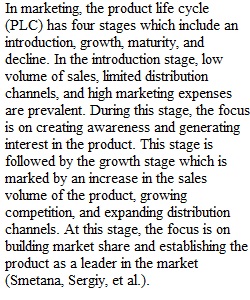


Q Week 6. Developing New Products & Product Life Cycle Chapter 9 Chapter Preview: New products are the lifeblood of an organization. However, new product development is risky and many new products fail. The first part of this chapter explains the process for developing and growing successful new products. Once introduced, marketers than want their products to have long successful lives. Takeaways: Explain how companies find and develop new product ideas. Describe the stages of the product life cycle and how marketing strategies change during a products life cycle. Read in the Textbook: Chapter 9. Developing New Products and Managing the Product Life Cycle. Assignment: One (1) page: Name and define the stages of the Product Life Cycle (PLC). Do all products follow this pattern? Assignment: One (1) page: What are the benefits of innovation in the restaurant industry? Assignments Due: Tuesday, 4/4 @ 11:59pm. Assignments will not be accepted after due date.
View Related Questions